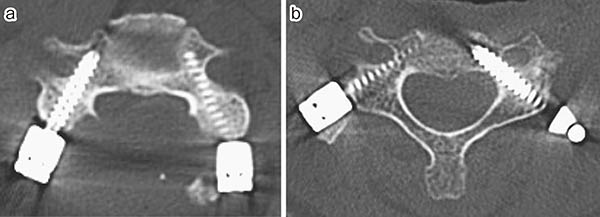- 著者
- Yoshihisa Sugimoto Takahiro Hayashi Takamitsu Tokioka
- 出版者
- The Japanese Society for Spine Surgery and Related Research
- 雑誌
- Spine Surgery and Related Research (ISSN:2432261X)
- 巻号頁・発行日
- vol.1, no.4, pp.218-221, 2017-10-20 (Released:2017-11-27)
- 参考文献数
- 17
- 被引用文献数
- 8 6
Background: To avoid lateral misplacement of midcervical pedicle screws, we developed a method for Minimally Invasive Cervical Pedicle Screw (MICEPS) fixation via a posterolateral approach. This intramuscular approach allows for horizontal pedicle screw insertion and reduced intraoperative bleeding. We reviewed our initial experience with MICEPS fixation for patients with cervical metastases.Methods: This study included 18 consecutive patients who received cervical spinal surgery for metastatic tumor. We treated 12 patients with conventional cervical pedicle screw fixation, and 6 patients with the MICEPS fixation technique. Average follow-up was 14 months (range 3 to 34). We inserted 117 pedicle screws using the navigation system. Average fusion area was 4.9 vertebrae (range 3 to 8). Alpha-angles between a line perpendicular to the posterior cortex of the vertebral body and the screw trajectory in the transverse plane were also measured.Results: The average surgical time was 250 min (range 151 to 420 min) with the conventional pedicle screw fixation and 234 min (range 154 to 300 min) with the MICEPS fixation. The average total blood loss was 780 mL (range, 180-1430 mL) in the conventional pedicle screw fixation group and 180 mL (range, 70-400 mL) in the MICEPS fixation group. At the level of midcervical (C3-5), average alpha-angles was 52 degrees (range 43 to 62) in MICEPS fixation group, and 39 degrees (range 19 to 55) in conventional cervical pedicle screw group.Conclusions: The MICEPS fixation technique uses an intramuscular approach, which is minimally invasive and reduces intraoperative bleeding. Intramuscular approach allows for horizontal pedicle screw insertion, and reduced critical screw deviation.
